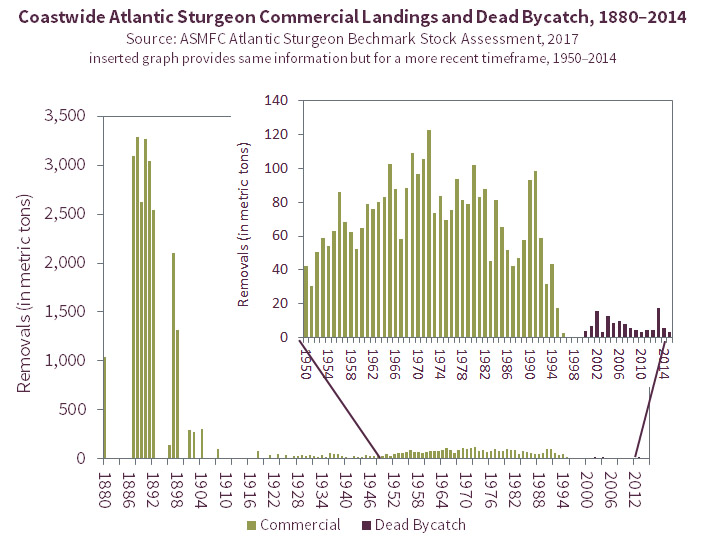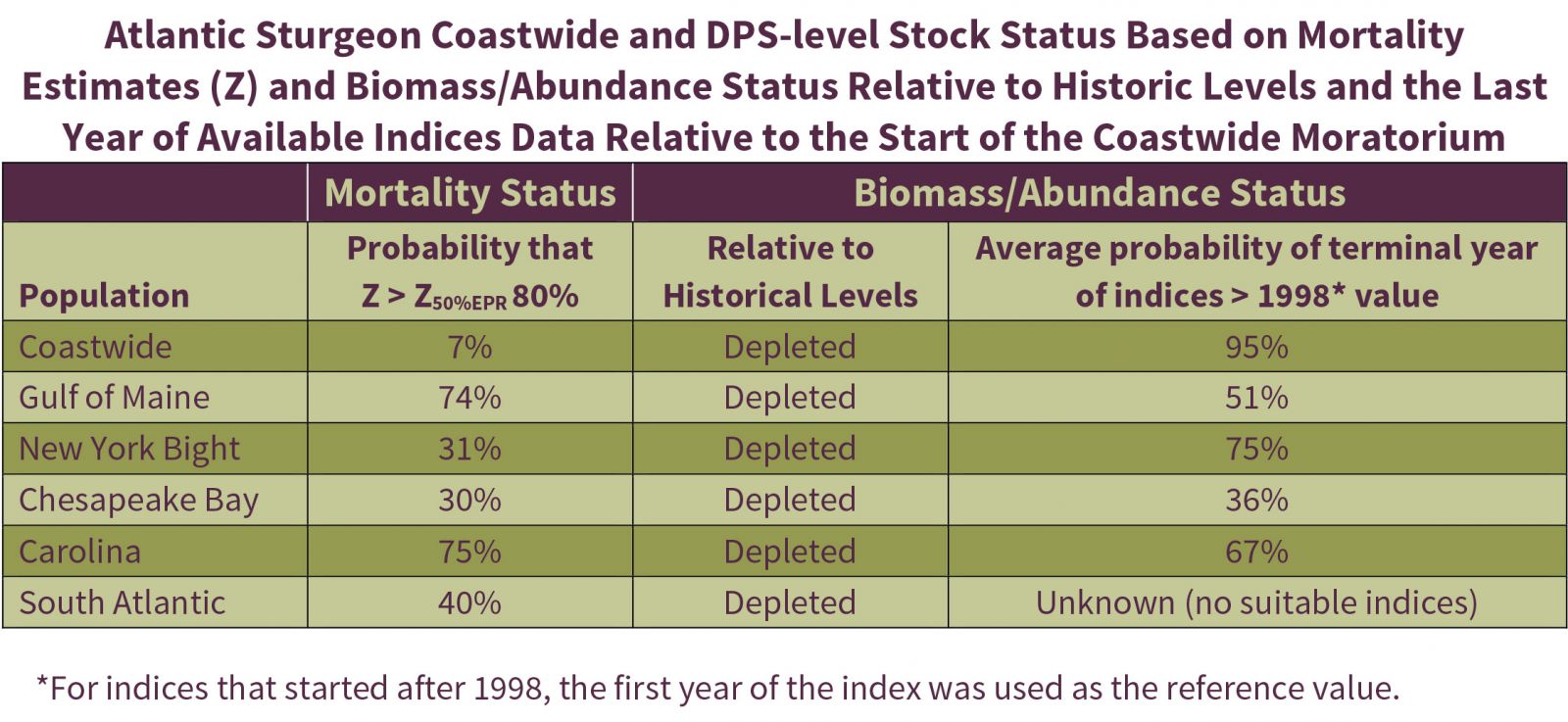Atlantic Sturgeon
Life History

Atlantic sturgeon being measured as part of a Cooperative Federal/State/Industry Atlantic Sturgeon Bycatch Reduction Survey. Photo © ASMFC.
Atlantic sturgeon (Acipenser oxyrhynchus) are ancient fish dating back at least 70 million years, and can be found along the entire Atlantic coast from Florida to Labrador, Canada. They are anadromous, migrating from the ocean into coastal estuaries and rivers to spawn. Atlantic sturgeon may live up to 70 years old, with females reaching sexual maturity between the ages of seven to 30, and males between the ages of five to 24.
Typically sturgeon inhabiting the southern part of the species range mature faster and grow larger than those in the northern part of the range. Females reach sexual maturity between the ages of 7 and 30, and males between the ages of 5 and 24. The number of eggs that a female produces increases with age and size, which means that older and larger females are more valuable to the population because they produce more eggs (up to eight millions eggs per spawning event) than younger, smaller females (estimated 400,000 eggs per spawning event).
Most juveniles remain in their natal river from one to six years before migrating back out to the ocean. Little is known about the movements of Atlantic sturgeon when they are at sea. As juveniles, Atlantic sturgeon feed on flies, worms, shrimps, and small mollusks and crustaceans. As adults, they are opportunistic feeders and prey mainly on mollusks, snails, worms, shrimps and benthic fish. Very little is known about their natural predators.
Commercial & Recreational Fisheries

Since colonial times, Atlantic sturgeon have supported commercial fisheries of varying magnitude. In the late 1800s, they were second only to lobster among important fisheries, with landings estimated at seven million pounds per year just prior to the turn of the century. Overharvesting of sturgeon for flesh and eggs (known as caviar) continued through the 1990s until the Commission and federal government implemented a coastwide moratorium in late 1997 and early 1998. Because the population has been severely overfished, the Commission's Fishery Management Plan for Atlantic Sturgeon calls for a coastwide moratorium through at least 2038, in order to build up 20 year classes. Several facilities culture Atlantic sturgeon for research purposes.
Stock Status

The 2017 benchmark stock assessment concluded that the resource was depleted coastwide. The “depleted” determination was used instead of “overfished” because of the many factors that contribute to the low abundance of Atlantic sturgeon, including directed and incidental fishing, habitat loss, ship strikes, and climate changes. While overall levels of Atlantic sturgeon remain low, the population appears to be recovering slowly since the implementation of a coastwide moratorium in 1998, and the current mortality level is indicated as sustainable. While Atlantic sturgeon is still considered a “data-poor” species, a tremendous amount of information has been collected on the species since 1998 that improve the abilities of managers and scientists to manage the species. States have invested considerable resources to increase understanding of sturgeon biology and life history. Additionally, bycatch, survey, tagging and genetic data were collected from dozens of state and federal agencies and academic programs along the coast to inform the latest benchmark stock assessment.
The coastwide Atlantic sturgeon population is made up of five distinct population segments (DPSs): (1) Gulf of Maine (GOM), (2) New York Bight, (3) Chesapeake Bay, (4) Carolina and (5) South Atlantic. Very little is known about stock status because reliable data are difficult to obtain; many river systems have few fish and particular stretches of rivers known to support sturgeon are often not easily sampled. However, several states have been conducting long-term monitoring of Atlantic sturgeon through fishery-independent surveys. Data from two of these surveys are included in the accompanying graph and provide a snapshot of local conditions. In 2016, 103 sturgeon were caught in the Albemarle Sound survey. This is the fifth highest in the 1991-2016 time series; the highest was in 2013 with 140 caught sturgeon. Catch per unit effort (CPUE) for this survey has remained above the long term average of 0.015 since 2012 and increased to 0.029 in 2016. 2016 survey results for the New Jersey coast were about average for the time series (1989-2016); 13 sturgeon were caught with a CPUE of 0.07. However, in 2015, the survey caught 32 Atlantic sturgeon which is the third highest catch in the time series (the highest was in 2006 with 35 sturgeon caught). The 2017 benchmark stock assessment indicates that all DPSs remain depleted, and the Gulf of Maine and Carolina DPSs are experiencing the highest mortality, while abundance in the Gulf of Maine and Chesapeake Bay DPSs is less likely to be at an increased level since the moratorium when compared to the other DPSs.
In 2012 following several status reviews, NOAA Fisheries declared the GOM DPS as threatened and the remaining DPSs as endangered under the Endangered Species Act (ESA). The status review determined the most significant threats to all five DPSs are bycatch mortality, poor water quality, lack of adequate state and federal regulatory mechanisms, and dredging activities. Additional stressors include habitat impediments and ship strikes. In 2013, NOAA Fisheries published an Interim Final Rule for the threatened GOM DPS which essentially provides the same protection as an endangered listing. In April 2017, NOAA Fisheries published a final rule to designate Atlantic sturgeon critical habitat (i.e., specific areas that are considered essential to the conservation of the species) in each of the DPSs.
Atlantic Coastal Management
Atlantic sturgeon are managed in the U.S. through Amendment 1 to the Interstate FMP for Atlantic Sturgeon and its associated Addenda I-IV. The primary goal of the amendment is to achieve stock recovery. Under Amendment 1, each state and jurisdiction “must maintain complete closure, through prohibiting possession of Atlantic sturgeon, and any and all parts thereof including eggs, of any directed fishery for and landings of Atlantic Sturgeon until the fishery management plan is modified to reopen fishing in that jurisdiction.” Exceptions to the moratorium on possession were approved via Technical Addendum #1 (2000) for the purposes of scientific research and educational display. The Amendment also addresses Atlantic sturgeon mortality associated with bycatch from other fisheries.
Addendum I (2001) exempts the State of Florida from the possession moratorium in order to develop private aquaculture facilities for cultivation and propagation of the species. Addendum II (2005) exempts a private company in North Carolina from the moratorium on possession, propagation, and sale of Atlantic sturgeon meat and eggs, and allows a Canada-based exporter to export Atlantic sturgeon fry and fingerlings into North Carolina. Addendum III (2006) similarly allows a private company in North Carolina to import Atlantic sturgeon from a Canada-based exporter. Addendum IV (2012) updates habitat information for Atlantic sturgeon and identifies areas of concern and research needs.
Management Plans & FMP Reviews
- Addendum IV: Habitat Considerations (September 2012)
- Addendum III (November 2006)
- Addendum II (May 2005)
- Addendum I (January 2001)
- ASMFC Terms, Limitations, Enforcement and Reporting Requirements for the Purposes of Permitting Importation of non-Indigenous Atlantic Sturgeon and the Development of Private Aquaculture Facilities (January 2001)
- Technical Addendum #1 to Amendment 1 (October 2000)
- Amendment 1 to the Interstate Fishery Management Plan for Atlantic Sturgeon (July 1998)
- Fishery Management Plan for Atlantic Sturgeon (November 1990)
Stock Assessment Reports
- 2017 Atlantic Sturgeon Benchmark Stock Assessment and Peer Review Report (Oct 2017)
- Atlantic Sturgeon Stock Assessment Overview (Oct 2017)
- Terms of Reference and Advisory Report for the American Shad and Atlantic Sturgeon Stock Assessment Peer Review (Mar 1998)
- Terms of Reference and Advisory Report for the American Shad and Atlantic Sturgeon Stock Assessment Peer Review (Mar 1998)
- Atlantic Sturgeon Stock Assessment Peer Review (Mar 1998)
Meeting Summaries & Reports
Technical Committee Meeting Summaries & Reports
- 2023 Feb
- 2021 Mar
- 2018 Jul
- 2016 Jan
- 2015 Dec Dec Jun Tagging WG Jun Bycatch WG May SAS
- 2007 Nov Atlantic Sturgeon Research Protocol Workshop Summary
- 2005 Sep